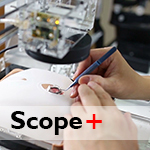Emerging Technologies
|
FCFull Conference Pass (FC - All Days)
FC1Full Conference Pass (FC - 1-Day Only)
BCBasic Conference Pass
ExExhibits Only
ETElectronic Theater Ticket
RTReception Ticket
|

Scope+ : A Stereoscopic Video See-Through Augmented Reality Microscope
During the process of using conventional stereo microscope, users need to move their head away from the eyepieces repeatedly to access more information, such as anatomy structures from an atlas. It happens during microsurgery if surgeons want to check patient’s data again. You might lose your target and your concentration after this kind of disruption. To solve this critical problem and to improve the user experience of stereo microscope, we present Scope+, a stereoscopic video see-through augmented reality system. Scope+ is designed for biological procedures, education and surgical training. While performing biological procedures, for example, dissection of a frog, anatomical atlas will show up inside the head mounted display (HMD) overlaid onto the magnified images. For education purpose, the specimens will no longer be silent under Scope+. When their body parts are pointed by a marked stick, related animation or transparent background video will merge with the real object and interact with observers. If surgeons want to improve their techniques of microsurgery, they can practice with Scope+ which provides complete foot pedal control functions identical to standard surgical microscope. Moreover, cooperating with special designed phantom models, this augmented reality system will guide you to perform some key steps of operation, such as Continuous Curvilinear Capsulorhexis in cataract surgery. Video see-through rather than optical see-through technology is adopt by Scope+ system, therefore remote observation via another Scope+ or web applications can be achieved. This feature can not only assist teachers during experiment classes, but also help researchers keep their eyes on the observables after work. Array mode is powered by the motor-driven stage plate which allows users to load multiple samples at the same time. Quick comparison between samples is possible when switching them by the foot pedal.
Presenter(s)
Yu-Hsuan Huang, Graduate Institute of Networking and Multimedia, National Taiwan University
Tzu-Chieh Yu, Department of Computer Science and Information Engineering, National Taiwan University
Pei-Hsuan Tsai, Graduate Institute of Networking and Multimedia, National Taiwan University
Yu-Xiang Wang, Department of Computer Science and Information Engineering, National Taiwan University
Wan-Ling Yang, Graduate Institute of Networking and Multimedia, National Taiwan University
Ming Ouhyoung, Graduate Institute of Networking and Multimedia, National Taiwan University, Department of Computer Science and Information Engineering, National Taiwan University

